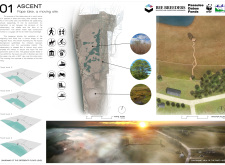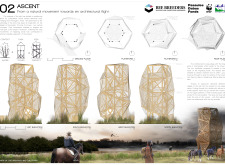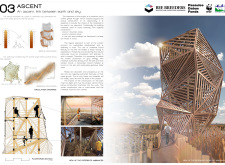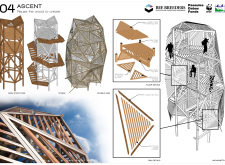5 key facts about this project
## Project Overview
The Ascent project is located in the Pape Lake region, designed as an observatory that facilitates human interaction with local wildlife, particularly migratory birds and various other fauna inhabiting the area. The intent is to create a space that promotes ecological observation and appreciation, fostering a respectful relationship between architectural design and the natural environment.
## Spatial Strategy
The design framework emphasizes verticality, inspired by the migratory patterns of birds. The main structure features a hexagonal form, which not only provides a unique visual identity but also functions as a series of elevated pathways and platforms. These elements create distinct observation points at varying heights, encouraging an immersive experience that allows visitors to engage with the landscape from multiple vantage points. Circulation routes, including ramps and stairs, mimic the organic paths of birds, enhancing accessibility while creating a dynamic sensory experience.
## Materiality and Sustainability
The selection of materials for this project underscores its commitment to sustainability and environmental integration. Alder wood, locally sourced to minimize transportation impacts, serves as a primary construction material, complemented by reeds and local stone, which further aligns with ecological principles. Recycled materials are also incorporated to promote a circular economy in construction. This strategic choice not only reduces the structure's carbon footprint but also fosters a symbiotic relationship with the surrounding ecosystem.
The architectural skin features patterns inspired by natural forms, enhancing both aesthetic appeal and structural performance. Open spaces throughout the design facilitate natural light and ventilation, thereby contributing to a comfortable interior environment for visitors.






















































